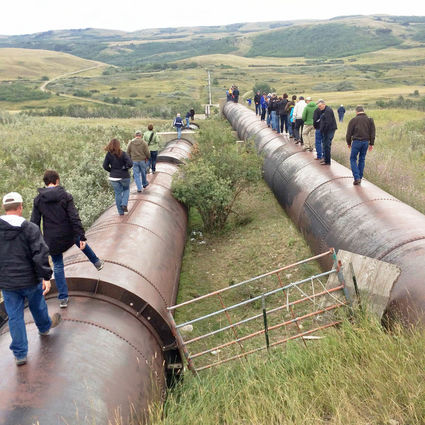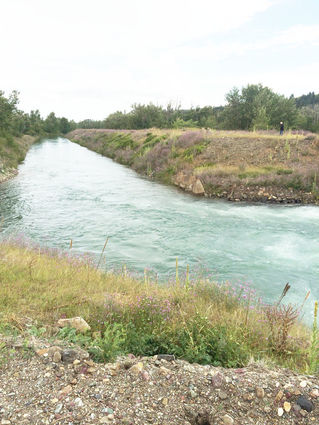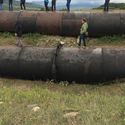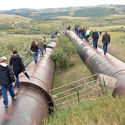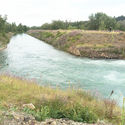Drop 5 near completion: St. Mary Diversion a Vital Resource to all in the Milk River Watershed
August 19, 2020
Water is essential to everyone, and for those of us who call North Central Montana home it carries added meaning. Our area of the country tends to exist in drought conditions far more often than not. We are all aware of the importance of moisture to our local Agriculture producers, be it in the fields as the crops grow, or providing adequate water supplies to their livestock. Many of our local producers rely on irrigating to farm their land and many more draw from the Milk River to provide stable water for their operations.
Currently the St. Mary's Diversion and the Milk River Irrigation Project (MRIP) are at a critical point that is vital to the well being of every citizen in the region. The Diversion essentially consists of five drop points that divert water from St. Mary to the Milk River after it re-enters the United States. On May 17, 2020 Drop 5 suffered a catastrophic failure requiring immediate repair. Drop 2 was already scheduled repair and was included in an emergency repair plan.
Chinook resident Greg Jergeson has represented the region in many public capacities and is involved the MRIP as well. "Right now, with the work being done on Drop 5, there is no new water coming into Fresno," said Jergeson. "If Drop 5 gets completed, then the old drop 2 could be used to get water flowing again." This is important to all citizens in Havre, Chinook, Harlem and the Fort Belknap Indian Reservation. In addition to providing water for irrigation it also provides all the water to these locales public use in homes, businesses, watering of lawns etc. "Right now, there are contingency plans that include water being stored in Fresno to hold enough water for these towns to have sufficient water to get through the winter," added Jergeson. Dolores Plumage represents the Fort Belknap Indian Reservation.
In a press release last week, MRIP Project Manager Jennifer Patrick stated, "We are twelve weeks and two days into this project from failure. Drop 2 is moving along nicely and we should be finished pouring on this structure end of this month. All but one concrete strength test has passed in 14-days and the other one we are confident will come around very soon. This is better than the projected 28-day strength tests, so we are optimistic these concrete qualities will extend into the Drop 5 pours as well."
Patrick went on to say, "Last week some very big decisions and strides were made on the Drop 5 foundation, designs and dewatering efforts. Currently, we are waiting on the specified rebar to be delivered to site, which should be this week and Drop 5 will be also start to take shape. The site grading from this week to last week has also changed and it doesn't look like an explosion took place. Drop 5 is also longer and gives the crews an opportunity to hopscotch the pour schedule a little more than Drop 2."
"2020 has been quite the year, but we all need to remind ourselves we are twelve weeks and two days from the failure and we poured our first round of concrete on Drop 5 yesterday, and if all continues, our last round on Drop 2 in two weeks," concluded Patrick.
When it comes to the public, many of whom who are not involved in the agricultural processes directly, how aware are they about how municipalities get water for our personal use?
The quick answer, The St. Mary's Diversion and the Milk River Irrigation Project. The St. Mary's River begins in Montana on the Blackfeet Indian Reservation and flows into Canada while the Milk River begins in Glacier Park before entering Canada and then again crossing back into the United States above Fresno Reservoir.
In short, an agreement reached between the United States and Canada to an equal share of the water from St. Mary and the Milk River during the irrigation season. Stated in the agreement is that 75% of the water from the Milk River would be kept for irrigation of the Milk River Water Shed and 25% would flow into Canada during irrigation season (below 666 cubic feet per second). 75% of the St. Mary water would go to Canada with 25% remaining in the United States.
To make this happen a diversion was created to fees water from Lake Sherburne and St. Mary through a canal to connect with the Milk River as it crossed back into the United States and supply water 800 irrigators who work about 150,000 acres from Havre to Glasgow. Settlement of claims between the two countries was reached with the Bounty Waters Treaty of 1909 leading to the eventual completion of the Milk River Irrigation Project which began in 1907 and was completed in 1939.
Much of the MRIP was completed by 1924. In all, the project involved the construction of roughly 419 miles of canals and laterals, which run above ground and resemble a pipeline. These canals carry the water through massive pipes that drop in elevation at each drop point to maintain flow. At Drop five the water is released back to an open flow where it eventually runs into the Milk River.
Also constructed as part of the project were seven major storage and diversion dams making reclamation of 125,000 acres of Agricultural land possible in the lower Milk River Valley. Fresno Dam was completed in 1939 by many workers who had just completed work on the Fort Peck Damn. As a result, the MRIP provides water to 18,000 Montanan's while at the same time providing Ag Producers with enough irrigated cropland to feed one million people.
The project itself, at over 100 years since its beginning, has received regular maintenance and updates but the failure of Drop 5 furthers the need to modernize the system.
On May 2, 2019 a press release stated Congressman Greg Gianforte and U.S. Senators Steve Daines and Jon Tester had introduced legislation to increase critical investments in the Milk River Infrastructure Project.
The St. Mary's Reinvestment Act will ensure that the federal government picks up 75 percent of the costs for upgrades to the century-old water project. Currently, the federal government only funds 26 percent of the project, leaving local users with the responsibility to pay the rest of the tab. This legislation is still pending.
The Milk River Project is among the oldest of the Bureau of Reclamation's infrastructures and the repairs to Drop 5 are extensive. No failure of this magnitude has occurred in the history of the elaborate ditch system. "There has not been an interruption to this extent," said Steve Davies, area manager for the Bureau of Reclamation in Billings, in an email. "Historically there have been occasional shutdowns required for emergency repairs to a siphon or canal embankment, but those were typically 1-2 weeks at most."
"There are some big worries with the loss of this water," said Patrick. Rainfall on central Montana's Hi-Line during the summer months is anything but certain. After June, the average monthly rainfall drops to about an inch by September. The last drought to hit the area was just three years ago.
Drop 2 has not collapsed but plans to replace it in anticipation of failure were already in the works before the Drop 5 collapse. The other three drops are in better condition, Davies said, having benefited from "various degrees of maintenance." The price tag for replacing both drops is "very roughly" $8.5 million, Davies said Monday. DNRC Director John Tubbs estimated the repair at about $8 million.
The St. Mary and Greater Milk River Project systems have been in need of an overhaul for decades. On Nov. 18, 2003, then-Lt. Gov. Karl Ohs convened a meeting in Havre to raise awareness about the urgent need to rehabilitate the aging infrastructure. Finding the estimated $200 million to complete the task has been the barrier.
The problem hasn't gone unnoticed by Montana's federal legislators.
Two days after the failure, Sen. Jon Tester, D-Big Sandy, wrote to BOR Commissioner Brenda Burman, emphasizing that water users should not be burdened with an "unreasonable cost" as repairs commence.

